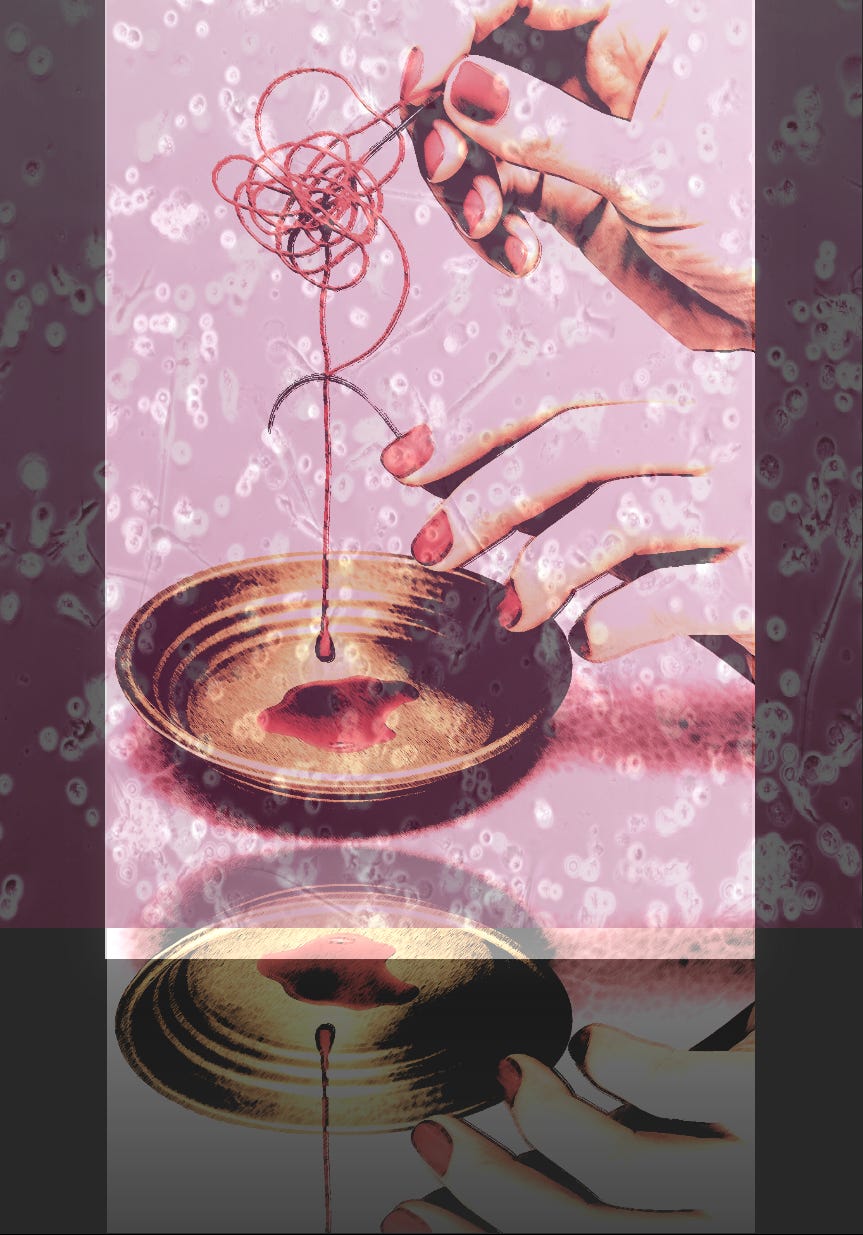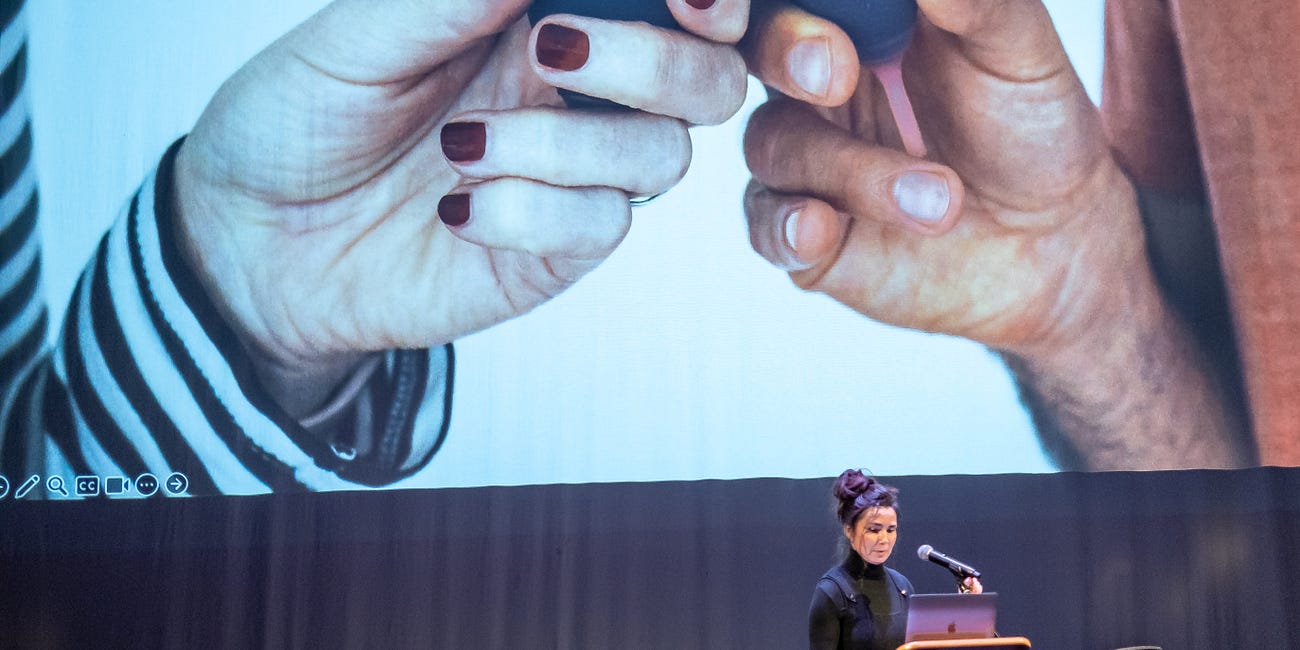The Red Rush
Period Profit and Influencer Feminism
Earlier this year, I addressed an issue that I call “Influencer Feminism” and the viral grab, with relation to all things menstruation.1 Since then, I’ve seen an acceleration of the marketing hype, false claims, and titillating buzz around menstruation, menstrual blood, and menstrual stem cells—all couched in sensationalist and technosaviourist narratives, typically delivered as a scenario of woman-to-woman gossip, creating a sense of shared intimate knowledge between confidantes (for a burgeoning consumer crowd). I’ll call this heightened hype acceleration the "Red Rush.” Blood drops for dollars, folks! This is the new paydirt of the 2020s.
What does this mean for my art, my research, and my integrity—not only as an ideas, images, and materials generator but as a knowledgeable practitioner with those menstrual materials? I began working with menstrual blood as an artist (and witch) over 25 years ago, but importantly here, I have pushed very diligently for close to a decade to be allowed to experiment with menstrual blood in the lab, fulfilling nested sequences of procedural requirements in order to conduct research ethically. This labour imbued me with a clear ethical lens, which informs the ways in which I take risks. Fully understanding ethics before taking experimental scientific or creative risks is essential to protecting others, as well as maintaining credibility in one’s professional career. Spending decades building the research profile I now enjoy means I take this very seriously—particularly since my work continuously pushes boundaries and gets continuous pushback.
I want to recap some of the hurdles I’ve overcome (and still work to overcome) to gain permissions for bringing a tube of my own menstrual blood down the hall from the bathroom and into a lab space;2 this is a repeat process of crossing thresholds for each new set of experiments, in each new institution that hosts me. It is important to share so that there can be some understanding of how this kind of research progresses, from idea to results. It certainly doesn’t happen like an exaggerated flash of realization, as portrayed in TikTok videos or Instagram reels: *gasp*—did you know that…. It happens through commitment, persistence, tenacity, focus, peer collaboration, and importantly, through embodied knowledge and skills development built over years. It also happens through legal and bureaucratic procedures—often painful procedures, akin to uterine cramps (just kidding, but they are tedious and can feel debilitating).
What gets obscured in the now-frenzied Red Rush is not only ethics but labour: patient, painstaking, often invisible (in many cases, female) labour of navigating institutions and day-by-day cultivation of the kinds of embodied skills I mentioned.3 This labour comprises some of the procedural content that finds its way into my artworks through performance videos. This is because I’m intent on re-visibilizing such labour, not only for the sake of integrity but also as a feminist biopolitics. And, to be clear, someone performing a script about menstrual stem cell facts (when another researcher has done the work to gather and compile them) whilst donning a lab coat and gloves, and even standing around in a generic lab space, does not make that person an expert though they costumize the role and pretend the labour.
Bureaucracy and labour issues don’t necessarily make for gripping reading, I know—but without this scaffolding there is no real research, no fully materialized art, no concrete results. The scaffolding itself shapes the work, determining what’s possible, what gets deferred or scrapped altogether, and what is required to be reinvented somehow; this becomes a call for more creativity (for me, at least). Right now, with regards to research and outputs surrounding the apparent magic of menstruation, I’m seeing a lot of fool’s gold, sold by new prospectors, backed by questionable investors, and marketed to an audience desperate for real solutions. As the recognition of the need for more research around women’s health surfaces, so too do the prospectors.
The bio-hype is like a flash flood, and biosciences and bioart research is conversely an endless uphill carry of buckets. Those buckets fucking matter: they (literally) hold the actual substance, the knowledge that will endure beyond tech trend cycles. The grinding, unglamorous reality of risk assessment forms, biosafety approvals, training modules and certifications, ethics board reviews, requisite vaccinations, and repeat applications are part and parcel of work to do with the body, its functions, and how these get applied clinically and culturally to a wider lay population.
At least three or four times now, I’ve had others capitalize, or attempt to capitalize off of my skilled labour while obscuring, misrepresenting, or minimizing my original intellectual and material contributions.4 The problem for them is that my labour is deeply intertwined with my intellectual property (the outputs), and this is intentional on my part, patents be damned. My labour is my art, so that the object is not separate from the process, but provides a material record. This is the legacy of a craft background: I’m distinctively hands-on as proof of my ideas. I’ve adapted this process-based philosophy to my laboratory practice and artistic works, and publicized them widely. Currently, there is a new startup company I have been legally advised I could sue for clear intellectual property (IP) rights infringement and misrepresentation, after I caught them red-handed. Interestingly, IP frameworks for artists and scientists don’t map neatly onto one another (I bridge both), but that is a discussion for a later date.5
Back to the nitty-gritty: My first bloody biotech project (in 2017) was cultivating pigment-producing species of bacteria on menstrual blood agar plates. With the group of women researchers I was coordinating and collaborating with in the lab (as the PI and technician), I was the first to do this.6 After the work was published in a few different books and journals,7 I spread the idea and taught the method to a number of artists, designers, and researchers through my online course, Bioart Coven.8 This gynecentric approach has since grown: through daughter groups and independent researchers, who have played with developing new approaches, presenting new artworks and performances, and always crediting me (and even contracting me for further guidance). This is the kind of propagation I respect and require: reciprocal, transparent.
The amount of labour and hoop-jumping I did in 2017, to slide these experiments through the lab door and into the biosafety cabinet, was extreme and invasive. My group was allowed to experiment with our “waste” blood for a brief time, but the permission was later revoked after the new method was institutionally recategorized within a higher risk group. By then, I was on to other labs and other bureaucracies. When I taught this method for at-home (DIYbio) experiments during COVID lockdowns, it was with a level of realistic caution gained through practical knowledge (and patience) I’d gained in writing that 32-page risk assessment document for the university. Behind every cool-looking agar plate photo or microscopic video of live menstrual cells lies a mountain of paperwork and hours (days, months, years) of care.
The Red Rush thrives on spectacle, shortcuts, and borrowed shine. I want to emphasize that my practice (and the practice of many artists and scientists I have worked closely with) insists on the slow, sometimes excruciating integration of ethics, labour, and imagination. Menstrual blood in biotech is not a gimmick nor marketing hook but the result of years of persistence, negotiation, refusal to separate body from knowledge, process from product—and it outright refuses to instrumentalize women for shady profits. One must always dig and ask: who is benefitting most? I want my work to circulate because it is built on lived experience, on craft, and on risks taken consciously, not for clicks or quick capital, even as the hype accelerates around me.
Heads up: I’ll be in Slovenia in a couple of weeks time, to present my current bioprinting work at the Taboo—Transgression—Transcendence in Art & Science conference in Llubljana!9 See you there? If not, I’ll be posting next on the wild and raucous event it promises to be!
You can read that post here:
Influencer Feminism and the Viral Grab
The above image, which comes from my most recent keynote lecture delivered last week at University College Cork, is the perfect icon for one of the subjects I’m about to discuss in a most critical fashion. Namely, I want to assert that nobody should be knocking …
I wrote a case study about this in a co-authored paper for the International Journal of Bioethics and Ethics of Science in 2018 (published in 2019), called Horizontal Exchange, Relations, and Resistance in Bioart and Practice-based Research, here: DOI:10.3917/jibes.304.0069
I recently read a well-considered case study of this kind of undervalued and under-recognized laboratory labour performed by women researchers, in the book, Vagina Obscura: An Anatomical Voyage by Rachel E. Gross. In “Chapter 5: Creation (Egg Cell),” Gross tells the story of Miriam Menkin, an “assistant” researcher who was a highly skilled and knowledgeable researcher in her own right, and the first to successfully experiment with and document the early stages of in vitro human egg fertilization. Menkin paved the way for IVF as we know it, yet was never adequately recognized in her field during her professional career. For more, check out Gross’ book, pages 117-147. Well worth the read.
I’ll be writing about this more in my forthcoming book, Sex, Blood, and Biotech in Art: The Witch in the Lab Coat. More on that to come.
I will be giving a lecture (or two!) on ethics and the conundrum of scientific IP versus artistic IP, likely in the new year. Stay tuned.
The first to ever document doing this, anyway. There was no one else that I knew of who had done this, and nothing to be found in the existing literature. Here I want to give a nod to Marc Beaulieu, friend, colleague, and Head of Technical Support and Infrastructure at the Milieux Institute, for being intellectually and technically invested in our work. Marc was the one to first brainstorm with us about the possibilities of using our own blood for our experiments.
One publication is the ethics journal I link to above in endnote 2; another is a Chilean publication titled, De Cobre, Microbios Y Arte (André Barbet, Giorgio Boccardo, and Andrés Marcoleta, eds.) published by Facultad de Artes Universidad de Chile, 2021. You can access the book here: https://artes.uchile.cl/publicaciones/176192/de-cobre-microbios-y-arte. My work is on page 36.
This course was delivered through the School of Machines, Making and Make-Believe (Berlin) in 2020 and 2021.
Huge thanks to the SFU School of Interactive Arts & Technology for granting me a SFU Vice President Research & Innovation Travel Award to support my trip.





For related reading, check out the book, Capitalizing on the Curse: The Business of Menstruation by Elizabeth Arveda Kissling.
Very interesting perspective! Thanks for sharing these experiences.